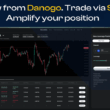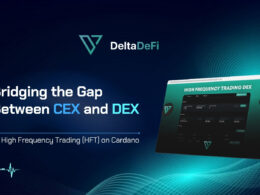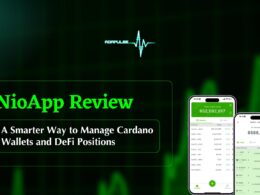Most people’s Web3 journey began with Bitcoin, the largest cryptocurrency by market capitalization. However, they haven’t since found ways to expand its utility. Bitcoin has massive liquidity, as does its user base, yet it remains underutilized outside of BTC-only platforms. Past the store of value and the recently approved ETFs, the rise of Bitcoin DeFi is rapidly growing, offering new opportunities for liquidity provision, yield generation, and asset interoperability. Any holder can collateralize their Bitcoin and earn yields.
The complete utilization of Bitcoin’s liquidity is something we look forward to, not least because the first-ever on-chain transaction between Bitcoin and Cardano happened. More importantly, because integrating Bitcoin into DeFi yields notable benefits. The merits extend beyond enhanced security, increased investment diversity, and the strengthening of decentralization within the financial ecosystem.
The Wanchain bridge connects BTC to other major networks, and you’ve likely received some Bitcoin in your Cardano wallet, like Lace. By moving Bitcoin across chains, we take practical steps to unlock its potential. This is only the baseline. A good example is using BTC in Cardano DeFi, which is the subject of this column in its full detail.
In this article, we introduce BTCGrow.io and its connection to the Cardano ecosystem. We will explain the integration of BTCGrow.io with Danogo. Then, we spotlight the benefits of holding BTC in Danogo on the Cardano DeFi. After outlining the risks associated with cross-chain transactions in DeFi, we showcase use case scenarios with examples and compare BTCGrow.io with other bridges. We close with Danogo’s role in Cardano’s DeFi growth.
What Is BTCGrow?
In its reverent light paper, BTCGrow subjects itself to the digital economy as a medium that allows you to earn passive income from your Bitcoin while maintaining explicit control over your assets. When BTCGrow went live, it introduced a permissionless decentralized non-custodial staking protocol through Wanchain and Cardano smart contracts. Simply put, BTCGrow explained is all about a gateway for Bitcoin into Cardano.
The primary mission of BTC Grow is to unlock Bitcoin’s earning potential without compromising its core principles, including self-custody and security. On a high level, Bitcoin flows to Cardano DeFi on the BTCGrow platform by locking native BTC to Wanchain, which, in turn, issues Wrapped BTC (wanBTC) tokens, directly usable on Cardano. BTCGrow’s asset management smart contracts on Cardano receive the freshly minted wanBTC and then supply it to a decentralized lending protocol. In this case, Danogo is the battle-tested, already in use platform.
The rationality behind the choice of Cardano can be narrowed down to four important reasons. One, Cardano is a truly decentralized network with around 3,289 active stake pools (at the time of writing) and has an active on-chain governance. Two, Cardano provides predictable and low-cost transactions, meaning affordable and deterministic earnings. Third is the UTXO model, which is compatible with BTC and makes it easier and safer for smart contract integration. Lastly, Cardano is a security-first product, built on Plutus/Aiken, with on-chain validation for all interactions, and is backed by a large, open-source, and community-driven initiative.
How BTCGrow Connects to the Cardano Ecosystem
A key question that arises is how Bitcoin on Cardano works. The answer to that is the Wanchain Bridge (Wan Bridge), which connects Cardano to many major L1s and L2s in a decentralized manner. A bridge is just a network that links blockchains and securely transfers assets from one to another. This is only possible when the bridge understands the transactions, consensus mechanisms, and execution environments of the blockchains connected to it.
To understand the technical flow of how BTCGrow works with the Cardano ecosystem, we’ll dissect the key components of its architecture. By name, they are the decentralized network, bridge asset management, and the lending protocol, Danogo.To use BTC on Cardano, BTCGrow first mints native BTC into WanBTC on Cardano. To the best of our knowledge, Wan Bridge operates as a decentralized network of permissionless bridge nodes that rotate monthly.
Wanchain Bridge: Secure Bitcoin Transfers to Cardano
The technology behind Wanchain consists of two components: “Secure Multiparty Computation (sMPC)” and “Shamir’s Secret Sharing” cryptographic techniques. The first is a criterion that allows many parties to compute a function based on each private input collectively, and the latter is an efficient algorithm that distributes private information among the parties. In harmony, these two cryptographic techniques lock, mint, and release assets across chains. This operation model safely locks native BTC during the wrapping process, makes wrapped BTC verifiable in its backing and redeemability, and allows arbitrary data to transfer between Bitcoin and Cardano.
Next in line is the bridge asset management, the core ledger of BTCGrow, a smart contract with core Cardano capabilities, ownership, staking, deposits, and withdrawals, etc. As the second component, it ensures your BTC ownership is verifiable and still transparent on-chain, it routes (sends) wanBTC to the Danogo yield-generation protocol, and keeps withdrawals at your convenience.
The final piece is the Danogo flexible pool lending protocol, which generates yields once wanBTC is supplied. By depositing wanBTC to borrowers on-chain to both retailers and leveraged trading platforms, lenders earn interest gained from the borrowing activity. Yield opportunities grow as liquidity demand grows. The image below demonstrates the technical flow with the right side as your entry with Bitcoin, and the left end shows tokenized BTC on Cardano consumed in DeFi protocols.

BTCGrow and Danogo in Action: The Integration Explained
Now that you understand how BTCGrow integrates with the Cardano ecosystem, let’s map a user’s journey. From owning BTC to generating yields on Cardano and making withdrawals, providing insight into the functional layer. This is how BTC works with Danogo in practice:
Stake BTC, Stay in Control
Jane, a Bitcoin holder, heads over to BTCGrow DApp and connects her wallet. Only the OKX, Unisat, and XVerse wallets are currently supported, with plans for additional integrations in the future. She enters the desired amount of BTC to stake, signs the transaction, and sends the BTC to WanBridge. WanBridge mints her BTC. A small fee is charged for this process. Note that before signing the transaction, Jane previews the network fee.
Once BTC is locked into BTCGrow, the transaction takes approximately 40 minutes to complete. WanBridge forges a wanBTC in a 1:1 ratio (1 BTC equals 1 wanBTC) on the Cardano blockchain through the bridge asset management smart contracts. In addition to tracking deposits, the contracts maintain ownership and ensure assets are routed to the Danogo Yield protocol. There’s no limit to how much Jane can stake as her Bitcoin is available for withdrawal at any time.
Earn Through Danogo’s Flexible Pools
At this point, Jane’s wanBTC are in Danogo’s flexible lending pool, where users supply assets and others borrow by providing collateral. Danogo calculates interest rates based on market supply and demand, using accurate prices from multiple independent oracles, including Indigo and Splash. In traditional peer-to-peer (P2P) protocols, Jane would have to interact with a borrower through a matching system. Danogo takes a new approach, allowing Jane to interact with the protocol directly.
Herein, Jane’s wanBTC isn’t funding an individual loan, it is instead contributing to a fungible pool. This is the reason why Jane (or anyone else who supplied an asset to Danogo) can withdraw funds at any time, provided there’s sufficient liquidity in the pool. In the Bridge Asset Management Smart Contract, Jane receives some dTokens equivalent to the pool’s ownership share. As Danogo accumulates interests from borrowed assets, dTokens increase relatively to the underlying assets. Jane earns from holding dTokens. This is her passive income.
Earn Through Danogo’s Leverage Trading
In addition to the lending protocol, Danogo supports leveraged trading on the Cardano blockchain, where traders can amplify gains, mitigate risks, and builders integrate leveraged positions into their DeFi applications. Jane’s BTC could have alternately been routed into this protocol. John, a cryptocurrency leverage trader and DeFi application builder, heads to Danogo DApp seeking capital-efficient trades on Cardano.
In his trading operations, John opens both long and short trade positions using ADA as collateral. He manages risks in adverse market conditions by utilizing short positions and incorporates leverage trading into his trade application for his stake pool by tapping into the Danogo Protocol. John makes some profit from both his personal trades and the trading application, and he pays off interest to Danogo for his loan. Jane earns profit from her BTC by providing liquidity to Danogo.
Note that in Danogo’s leverage trades, John initiates borrowing, swapping, and position creation in a single transaction. Danogo saves him the time and struggles of handling complex multiple steps that require surgical-like precision. So, what happens when John’s loan has a poor health factor? He can swap his collateral to obtain the borrowed assets, use the amount to repay his loan, and then close the position safely, keeping the pool in balance.
The leveraged trading pool, too, similarly in design, works with other protocols by routing idle liquidity to external protocols alike. In other words, Danogo’s architecture balances capital efficiency such that no funds ever sit idle. Every token has a job even when not in use.
Exit Anytime: Full Bitcoin Redeemability
Time has passed, and Jane has been passively earning from her BTC in Danogo’s flexible and leverage trading pools. Remember, Jane initiated her BTC earnings through the BTCGrow DApp, where she tracks the accumulated interests since her deposit. If she wants to withdraw her earnings, there’s no lock-up or middlemen involved. All she needs to do is initiate it from the BTCGrow DApp. Danogo’s network pulls Jane’s wanBTC through smart contracts. The Cardano smart contracts send her wanBTC to the bridge, where it is burned, and an equivalent amount of native Bitcoin is released and transferred to her OKX wallet. This is the complete staking cycle on BTCGrow and Danogo, with neither centralized approvals nor slashing penalties.
Risks and Mitigations in Cross-Chain Bitcoin DeFi
Every venture is more or less a creation of value. There’s no value generation without risk involvement. BTCGrow builds around the core principles of Bitcoin, and Danogo enhances those in Cardano. On the note of risks, BTCGrow faces potential issues in the bridge and smart contracts. Should the bridge fail or smart contracts be vulnerable, funds could be lost or locked, or exploited. BTCGrow uses WanBridge, which is open-source and decentralized. Developers build all smart contracts with a security-first approach, audit them through third-party firms, and deploy them on testnet first to identify bugs with real user feedback. Danogo also publishes its third-party audit reports publicly. However, the crypto market is subject to volatility and price manipulation.
BTCGrow vs Other BTC Bridges in DeFi
The debut of BTCGrow on the Cardano ecosystem does bring a new wave of innovation. And yet we cannot dismiss established solutions like Ethereum’s wBTC and Avalanche’s BTC.b. A differentiating factor is that while these solutions may have entered the markets earlier, they rely on custodian intermediaries. These solutions include BitGo, which risks centralization. The same is true for wBTC on Ethereum, and it is no different from Alanche’s dependency on a federated bridge.
Building with Danogo gives BTCGrow stability, efficiency compared to those seeking similar services on account-based networks, Ethereum, for example. Cardano’s decentralization is a solid building block where the transaction fee is low and predictable. The same remains true even during high network activity times.
Moreover, projects like Rosen Bridge still continue to pioneer Bitcoin and Cardano connectivity toward hybrid applications. With the advent of Hydra and Sidechains, Cardano is continuously improving its scalability and BTCGrow. In turn, this would further extend its throughput and minimize latency for its Bitcoin settlement layer.
It is through this collaboration that BTCGrow and Danogo work in tandem to promote the utility and adoption of Bitcoin and Cardano blockchain networks. Other versions of wrapped BTC focus on custody and transfers. Distinctively, Danogo turns Bitcoin into a productive asset within the Cardano DeFi ecosystem. This marks the first complete bridge solution tapping into unused assets in the entire crypto space.
Expansion of Bitcoin Utility in Cardano DeFi
We need not chant about Cardano as Bitcoin’s DeFi. Instead, we ought to start using BTCGrow and Danogo, which are true testaments to technological innovation. BTCGrow is Cardano’s gateway to tap into Bitcoin. Danogo’s ecosystem is Bitcoin’s utility layer. With this collaboration’s awareness growing alongside technical advancements, more BTC liquidity will likely flow into Cardano, where it expands financial strategies for Bitcoin holders.
Not to be stressed much, but what’s next is here. You who’ve been reading this post and hold your Bitcoin locked in a vault, it’s time to tour Web3. We are live on mainnet, a chance to earn from your holdings, still you can still withdraw whenever you want. It is a new financial era. Danogo, in harmony with BTCGrow, is providing you with the best Bitcoin opportunities in the Cardano ecosystem.
BTC on Cardano is but another name for financial progress. That known to you now, the only big thing left is to actually get started. Head over to BTCGrow, connect your wallet, and clock in on your BTC earnings that you can actually withdraw anytime.










